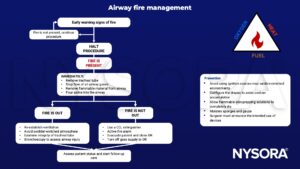Learning objectives
- Recognize an airway fire
- Management of an airway fire
Definition and mechanisms
- An airway fire is defined as a fire occurring in a patient’s airway
- May or may not include a fire in the attached breathing circuit
- All airway fires require three components known as the “fire triad”:
- Oxidizers oxygen and nitrous oxide
- Ignition source: electrosurgical devices, lasers, heated probes, burrs and drills, fiberoptic scopes, and defibrillator paddles or pads
- Fuel: tracheal tubes, sponges, drapes, gauzes, alcohol-containing solutions, oxygen masks, nasal cannulae, the patient’s hair, dressings, gowns, gloves, or packaging materials
Prevention
- Determine if the procedure is high-risk
- Agree upon a team plan and team roles for preventing and managing a fire
- Notify the surgeon of the presence of or an increase in an oxidizer-enriched atmosphere
- Before an ignition source is activated:
- Announce the intended use of an ignition source
- Reduce the oxygen concentration to a minimum needed to avoid hypoxia
- Stop the use of nitrous oxide
- Avoid using ignition sources near oxidize-enriched environments
- Configure the drapes to avoid oxidizer pooling or accumulation
- Allow flammable skin-prepping solutions to completely dry
- Sponges and gauzes should be moistened if used near ignition sources
- Airway laser procedures: use laser-resistant cuffed tubes and fill the cuff with saline tinted with methylene blue to identify a cuff puncture by the laser
Management

Keep in mind
The following supplies should be immediately available in the operating room:
- Several containers of sterile saline
- A CO2 fire extinguisher
- Replacement tracheal tubes, guides, facemasks
- Rigid laryngoscope blades including a rigid fiberoptic laryngoscope
- Replacement airway breathing circuits and lines
- Replacement drapes, sponges
Suggested reading
- Cowles CE Jr, Culp WC Jr. Prevention of and response to surgical fires. BJA Educ. 2019;19(8):261-266.
- Akhtar N, Ansar F, Baig MS, Abbas A. Airway fires during surgery: Management and prevention. J Anaesthesiol Clin Pharmacol. 2016;Jan-Mar;32(1):109-11.
- Apfelbaum JL, Caplan RA, Barker SJ, et al. Practice advisory for the prevention and management of operating room fires: an updated report by the American Society of Anesthesiologists Task Force on Operating Room Fires. Anesthesiology. 2013;118(2):271-290.
We would love to hear from you. If you should detect any errors, email us at customerservice@nysora.com







